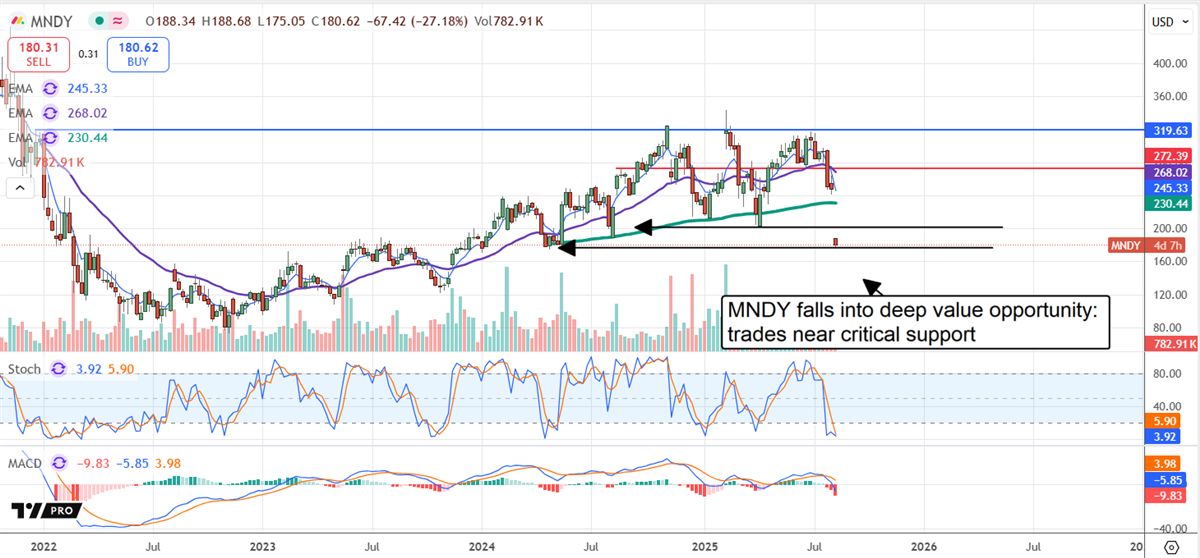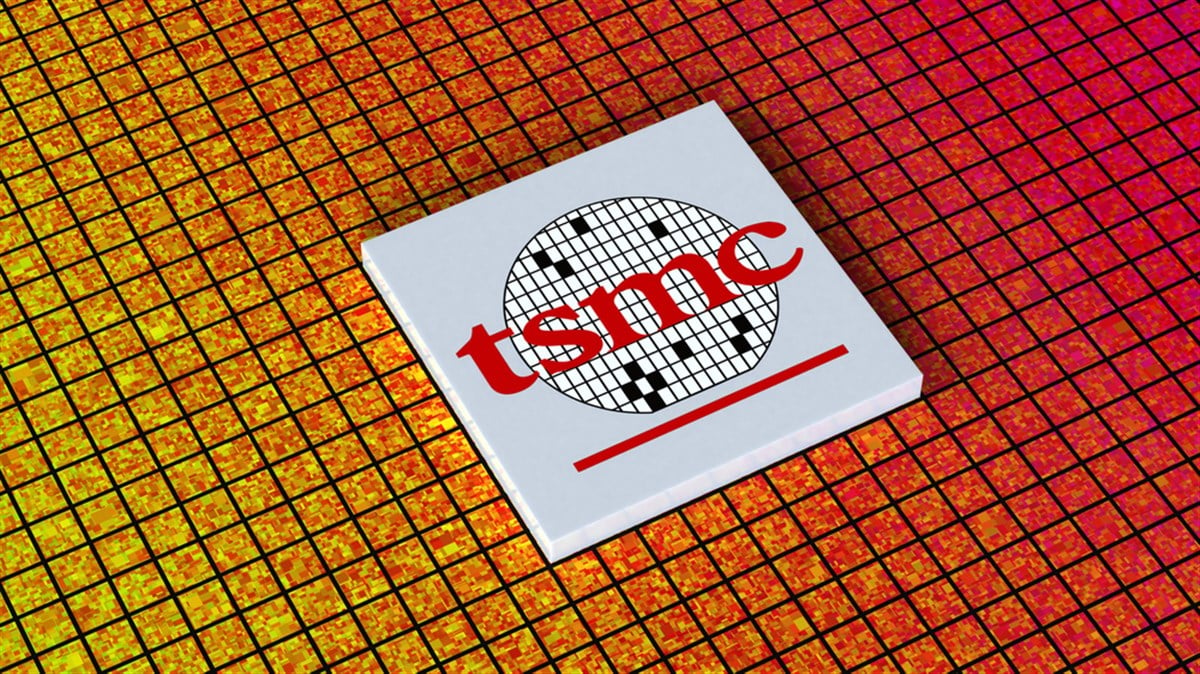| Written by Thomas Hughes 
Monday.com’s (NASDAQ: MNDY) August price plunge is not easy for its stockholders to watch, but there is good news. The drop is a knee-jerk reaction to tepid news compounded by relatively high short interest that discounts the company’s long-term outlook. It will likely not last long. Trading at roughly 7x the long-term earnings forecast ahead of the release, the nearly 20% price plunge deepened the value in this well-positioned cash-generating machine. Monday.com is a leader in workflow management and AI-empowered automation. Its technology and services enable organizations to automate workflows, manage projects more efficiently, and streamline operations, and are gaining traction with businesses and industries worldwide. There Was Nothing Wrong With Monday.com’s Q2 Results Monday.com reported a solid quarter with only two things marring the results. The first point is that growth is slowing sequentially, and compared to last year, the second is that the Q3 guidance was only as expected. The takeaway for investors is that growth was expected to slow, results were better-than-forecast, and Q3 guidance had been sufficient to sustain the higher share price ahead of the release; there is no reason why it shouldn’t be afterward. The more critical detail is that the Q2 strengths are expected to linger, and the full-year guide was improved. As of early to mid-August, the company's forecast indicates revenue growth of roughly 26%, which is 200 basis points hotter than MarketBeat’s reported consensus. Due to the business trends, this may be considered cautious guidance. The Q2 results are solid. The company outperformed MarketBeat’s reported consensus by more than 100 basis points, growing revenue by nearly 27% compared to last year. The gains were driven by an 8% increase in clients and an 11% increase in existing business, driven by the company’s largest client groups. They grew by 36% and 46% respectively. The margin news is also healthy. The company increased its R&D and faced expense hurdles, but managed to outperform the market’s expectations. The net result is a 100-basis-point contraction in the adjusted operating margin and $1.09 in adjusted EPS, up only 16% year-over-year (YOY) compared to the 26.6% top-line advance, but more than 2500 basis points better than expected and sufficient to produce a significant gain in shareholder value. Monday.com Builds Value for Shareholders Monday.com’s balance sheet health and growth are tied to dilutive share sales, but the company deploys capital efficiently and produces value for investors. The 2% YOY increase in share count and increased liability are offset by increased cash, current and total assets, which lifted equity by 18% year-to-date. Equity is expected to continue rising as the year progresses and drive robust support from the sell-side. Institutions, which own about 75% of the stock, provide a solid support base in 2025, and they are buying on balance as of mid-Q3 2025. The analysts, the vocal portion of the group, also provide solid support with their coverage increasing, sentiment firming, and price targets rising ahead of the release, indicating a deep value. Already trading below the low-end of the analysts' range ahead of the release, the post-release price plunge puts the stock well below, suggesting a minimum of 50% upside with the potential for a 75% gain at the consensus. Monday.com’s price decline may extend to even deeper levels, but there are signs that support is strong near $200. Numerous price upswings, including two in 2024 and two in early 2025, not only show support at the $200 level but also rising support aligning with an uptrend. The likely outcome is that, based on the results, valuation, and trends of institutions and analysts, this level will continue to serve as support. The market may consolidate near $200 before rebounding, but a rebound and fresh long-term highs are likely within a few quarters. 
 Read This Story Online Read This Story Online |  During a meeting in Washington D.C., Jeff Brown discovered a bold initiative.
He calls it "President Trump's Project MAFA," and it could soon return America to a "new" gold standard.
The Trump administration, Wall Street, and Silicon Valley are all pushing it forward. The President himself calls the plan "incredible."
Already, it's helping small plays jump as high as 300%, 318%, 520%, and even 600%.  You can watch it right here. You can watch it right here. |
| Written by Dan Schmidt 
It’s a hot IPO summer as new listings make their long-awaited return to public markets. After a cool first half of 2025, the demand for Initial Public Offerings has exploded in Q3, with anticipated companies like Circle Internet Group Inc. (NYSE: CRCL) and CoreWeave Inc. (NASDAQ: CRWV) surpassing even the rosiest expectations upon their debut. And it doesn’t appear that momentum is slowing as several more promising companies are unveiling their listings. Factors Contributing to the IPO Rebound in Q2 2025 A range of factors has kept the IPO market subdued recently. Not only was the macro-environment poor in the first half of 2025 due to erratic trade policies, but private companies have been staying private longer than historical norms. According to research from Morgan Stanley, companies are now staying private for nearly 11 years on average before going public, a significant increase over the seven-year average from 2014. Private companies aren’t scrutinized as closely as their publicly traded counterparts, and high rates have clogged the capital spigot over the last few years. Couple these factors with the rise of private markets, and there simply isn’t the enthusiasm for ‘going public’ as there was in the past. Only 84 IPOs were issued in the first half of 2025, down from over 100 in the same period last year. If there’s light at the end of the tunnel, it began shining earlier this summer. We’ve seen several new listings hit the market, and many have grown exponentially in the first day or week of trading. Three reasons for the turnaround include: - Investors' Appetite for New Issues: Of the 16 IPOs that have raised more than $50 million so far in 2025, nine of them occurred in June. Demand for IPOs has returned in a big way, and previously private companies are striking while the investment iron is hot.
- Momentum from Specific Sectors and Industries: You can probably guess which sectors we mean here. Artificial intelligence and its adjacent businesses continue to dominate the stock market, with some speculation in crypto and its adjacent businesses. CoreWeave and Circle soared during their first week of trading, showing investors are eager to throw money at anything AI and crypto-related right now.
- Anticipation of Accommodative Monetary Policy: A slowing job market is bad news for the economy, but if the Federal Reserve resumes its rate-cutting cycle in September, it could create cheaper capital for IPOs. High rates have limited the demand for new issues, and a reduction before the end of the year could further juice this hot market.
2 New Issues Garnering Investor Attention This Month The first wave of big IPOs this year saw companies like CoreWeave and Circle achieve impressive gains before volatility muted the fun. But July was another banner month for new issues; here are two debuting stocks to keep on your radar. Figma: Creating a Collaborative Environment for Design The biggest IPO debut since CoreWeave, Figma Inc. (NYSE: FIG), got off to an absurd start even before shares went public. After initially looking at an opening price between $25 - $28, the stock debuted at $33 and quickly rose toward $100 before hitting the exchanges. By the end of the first day, FIG shares were trading at $115, a shocking gain of more than 200% from the opening price. Figma has the financial data to back up its exciting first-week performance. The company has more than 13 million active users and earned more than $228 million in revenue in Q1 2025 (a 46% year-over-year (YOY) increase), with a net income of $44.9 million. FIG’s market cap surged over $67 billion after the first day of trading, although a 35% pullback sent shares back under $80 in the subsequent five sessions. Figma’s unique platform allows designers and professionals to collaborate on different interfaces in real-time, and with 85% of current customers outside the United States, the growth prospects remain strong despite the hefty valuation at about 40x sales. Figma’s impressive list of corporate clients includes Stripe, Duolingo, and Netflix Inc. (NASDAQ: NFLX). MNTN: First Mover Advantage in a New Advertising Space If you don’t mind seeing Ryan Reynolds in the C-suite and have an interest in innovative AI-based advertising companies, MNTN Inc. (NYSE: MNTN) could be an intriguing investment. Pronounced ‘Mountain,’ the company has a platform called Performance TV, which helps clients create specific, tailored advertising plans targeting viewers based on their Connected TV watching habits and demographics. Connected TV is simply any TV with an internet connection, such as a Roku TV or Amazon Fire TV Stick. MNTN reported its first earnings release as a public company on August 5, which missed analysts’ expectations on EPS but surpassed revenue estimates by 6%. The $68.46 million in revenue represented a 25% YOY increase, and the company has a distinct first-mover advantage in this space thanks to partnerships with Peacock, ESPN, CBS, and Fox. MarketBeat is already tracking 10 analysts covering the stock, with two Hold ratings and eight Buy ratings. The consensus price target is $29.90, which suggests upside of nearly 20% from current prices.  Read This Story Online Read This Story Online |  |
| Written by Gabriel Osorio-Mazilli 
One of the biggest mistakes investors can make is constantly trading in and out of the wrong stocks, triggering one taxable event after another on their gains. While some smaller, more volatile stocks may lend themselves to short-term trading, others call for the opposite approach—a steady buy-and-hold strategy. Taiwan Semiconductor Manufacturing (NYSE: TSM) fits squarely into that second category. As a dominant force in the semiconductor industry, it holds a massive footprint in one of technology’s hottest areas. The sector is on the verge of major change as the United States moves to onshore chip manufacturing, especially with new trade tariffs targeting countries that supply much of the world’s semiconductors. With this in mind, Taiwan Semiconductor is a stock best suited for long-term accumulation—buying gradually and holding for an indefinite period. The reason goes beyond the company’s staggering $1 trillion market value. It also lies in the major investments and expansion into the United States that are set to unfold in the coming years. The Bull Case for Taiwan Semiconductor Stock There has never been an invalid bull case for this company. Still, today more than ever, investors should stay alert to the underlying issues that could push this stock to new record highs. Even though it already trades at 97% of its 52-week high, chances are new ceilings will be made in the coming quarters and years, despite what volatility may come its way. The reason is that President Trump is now increasing tariffs on semiconductors, and as recently announced on a live CNBC interview, his rollout points to a high of 200% tariffs by 2027, giving companies like Taiwan Semiconductors a concrete timeline to get their manufacturing capacity within the United States. This means investors can get in early on this massive move, as onshoring its presence will also allow Taiwan Semiconductor to remain one of the leading names in semiconductor equipment and technology, most of which is used by other giants of industry like NVIDIA Co. (NASDAQ: NVDA) and Apple Inc. (NASDAQ: AAPL). With a few years of gains nearly spelled out for investors, selling at the current highs would be futile, since they would only have to keep buying higher and higher, again stacking up more tax events for themselves unnecessarily. In fact, anyone who sells this stock today is most likely doing it for portfolio weighing reasons. For instance, institutional investors from Sanders Capital recently offloaded 7.8% of their massive $8.7 billion position in Taiwan Semiconductor. This should not be seen as a bearish sign, considering that this stock represents 11.6% of their portfolio, a recent run to 52-week highs likely bloated the stock to become too big a name in their book. This is a common practice at investment funds, where they reduce a name’s weight in a portfolio to avoid it becoming too big a constituent, thereby not necessarily indicating a change in sentiment or view toward the company. Where Taiwan Semiconductor Can Go Next This is a more abstract question that can be answered in the same way as it is traditionally responded to by investment banks on Wall Street. Taiwan Semiconductor stock trades at a price-to-earnings (P/E) ratio of 27.6x today, but it still offers a steep discount to the rest of the computer sector’s average of 50.3x. Perhaps some investors and analysts had discounted this stock due to fears that it was so exposed to the Asian region, where most trade tariffs seem to be focused. However, changing the game plan to onshoring in the United States renders this bearish view useless. That change alone could be the catalyst to bring Taiwan Semiconductor stock to a valuation more in line with where the rest of its peers are trading today in terms of P/E multiples. More than that, the fundamental story is strong enough today to make this happen. In the latest quarterly announcement, Taiwan Semiconductor's stock reported $2.47 in earnings per share (EPS) compared to the Wall Street consensus for only $2.13, reiterating the fact that even analysts may be looking at this company through an overly conservative lens. As compliance with global tariffs and changes in demographics clear the way for future growth, further EPS beats in the future may very well start to deliver the sort of upside Taiwan Semiconductor has been missing out on compared to peers. Therefore, trading this stock would be a costly mistake for impatient investors; this is a buy-and-hold name.  Read This Story Online Read This Story Online |  Elon's Next Market Move Could Send Silver Soaring
Every industry Elon Musk touches explodes—from Tesla to SpaceX to AI.
And now, whispers are growing that his next move could be in silver.
Why? Because silver is the lifeblood of EVs, solar panels, and AI tech. Smart money is already watching silver closely. |
|
0 Response to "🦉 The Night Owl Newsletter for August 11th"
Post a Comment